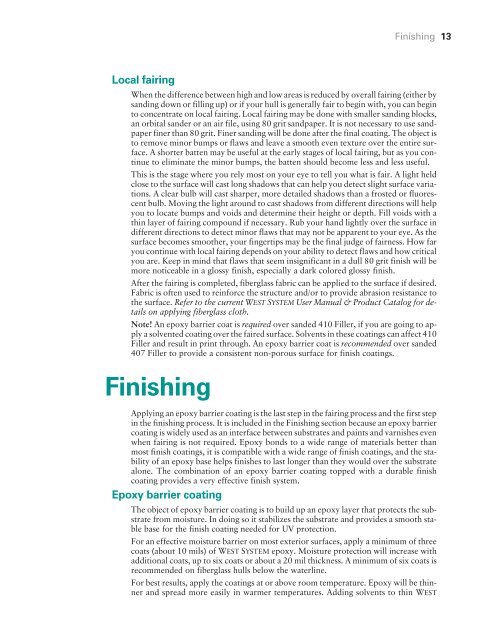Final Fairing & Finishing - WEST SYSTEM Epoxy
Final Fairing & Finishing - WEST SYSTEM Epoxy
Final Fairing & Finishing - WEST SYSTEM Epoxy
Create successful ePaper yourself
Turn your PDF publications into a flip-book with our unique Google optimized e-Paper software.
Local fairing<br />
When the difference between high and low areas is reduced by overall fairing (either by<br />
sanding down or filling up) or if your hull is generally fair to begin with, you can begin<br />
to concentrate on local fairing. Local fairing may be done with smaller sanding blocks,<br />
an orbital sander or an air file, using 80 grit sandpaper. It is not necessary to use sandpaper<br />
finer than 80 grit. Finer sanding will be done after the final coating. The object is<br />
to remove minor bumps or flaws and leave a smooth even texture over the entire surface.<br />
A shorter batten may be useful at the early stages of local fairing, but as you continue<br />
to eliminate the minor bumps, the batten should become less and less useful.<br />
This is the stage where you rely most on your eye to tell you what is fair. A light held<br />
close to the surface will cast long shadows that can help you detect slight surface variations.<br />
A clear bulb will cast sharper, more detailed shadows than a frosted or fluorescent<br />
bulb. Moving the light around to cast shadows from different directions will help<br />
you to locate bumps and voids and determine their height or depth. Fill voids with a<br />
thin layer of fairing compound if necessary. Rub your hand lightly over the surface in<br />
different directions to detect minor flaws that may not be apparent to your eye. As the<br />
surface becomes smoother, your fingertips may be the final judge of fairness. How far<br />
you continue with local fairing depends on your ability to detect flaws and how critical<br />
you are. Keep in mind that flaws that seem insignificant in a dull 80 grit finish will be<br />
more noticeable in a glossy finish, especially a dark colored glossy finish.<br />
After the fairing is completed, fiberglass fabric can be applied to the surface if desired.<br />
Fabric is often used to reinforce the structure and/or to provide abrasion resistance to<br />
the surface. Refer to the current <strong>WEST</strong> <strong>SYSTEM</strong> User Manual & Product Catalog for details<br />
on applying fiberglass cloth.<br />
Note! An epoxy barrier coat is required over sanded 410 Filler, if you are going to apply<br />
a solvented coating over the faired surface. Solvents in these coatings can affect 410<br />
Filler and result in print through. An epoxy barrier coat is recommended over sanded<br />
407 Filler to provide a consistent non-porous surface for finish coatings.<br />
<strong>Finishing</strong><br />
<strong>Finishing</strong> 13<br />
Applying an epoxy barrier coating is the last step in the fairing process and the first step<br />
in the finishing process. It is included in the <strong>Finishing</strong> section because an epoxy barrier<br />
coating is widely used as an interface between substrates and paints and varnishes even<br />
when fairing is not required. <strong>Epoxy</strong> bonds to a wide range of materials better than<br />
most finish coatings, it is compatible with a wide range of finish coatings, and the stability<br />
of an epoxy base helps finishes to last longer than they would over the substrate<br />
alone. The combination of an epoxy barrier coating topped with a durable finish<br />
coating provides a very effective finish system.<br />
<strong>Epoxy</strong> barrier coating<br />
The object of epoxy barrier coating is to build up an epoxy layer that protects the substrate<br />
from moisture. In doing so it stabilizes the substrate and provides a smooth stable<br />
base for the finish coating needed for UV protection.<br />
For an effective moisture barrier on most exterior surfaces, apply a minimum of three<br />
coats (about 10 mils) of <strong>WEST</strong> <strong>SYSTEM</strong> epoxy. Moisture protection will increase with<br />
additional coats, up to six coats or about a 20 mil thickness. A minimum of six coats is<br />
recommended on fiberglass hulls below the waterline.<br />
For best results, apply the coatings at or above room temperature. <strong>Epoxy</strong> will be thinner<br />
and spread more easily in warmer temperatures. Adding solvents to thin <strong>WEST</strong>
















